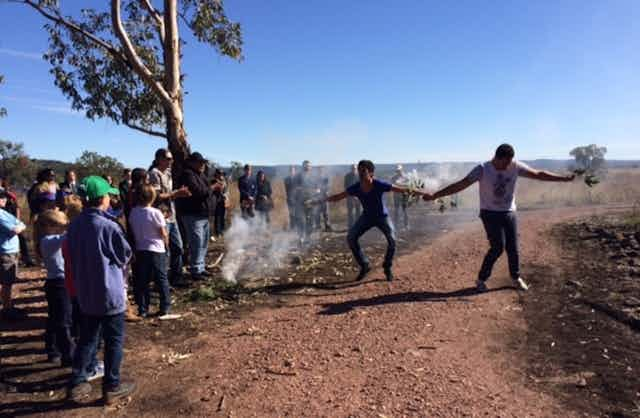This weekend, hundreds of people will make the pilgrimage to the small town of Bingara on the NSW North West slopes and plains, for the annual commemoration of the Myall Creek Massacre.
The memorial site, just out on the Delungra Road, marks the site of the massacre of 28 unarmed women, children and old men that occurred there on June 10, 1838. This is a place where terrible things occurred, a place shunned and avoided by locals, especially Aboriginal people, for over 150 years.
One could imagine that any memorial event here would be a sad and sombre affair. But while the ceremony inspires quiet reflection and deep sorrow, it also inspires a sense of hope, as we contemplate a future where reconciliation between Indigenous and non-Indigenous Australians is more than just a possibility.
It’s as if this place, with such a horrendous history, is being transformed by the people who year after year come to participate in a healing ritual. This transformation is what interests me as a researcher: how the rich ritual and recognition of our dark, shared history can heal both people and place.

Strangers united
I first attended the Myall Creek annual ceremony in 2000, the year that the memorial rock and serpentine walkway were first opened. It was amazing when approaching to see hundreds of cars parked in a paddock by the Myall Creek Memorial Hall, which honours soldiers killed in the First World War.
There was a buzz of excitement in the crowd, with lots of high profile Australians present, including Indigenous Leader Linda Burney and guest speaker John Anderson (then deputy Prime Minister). People had travelled from all over the state and beyond to be there.
We gathered under a soft grey winter sky, to hear members of the memorial organising committee tell the story of how this day had come to pass. It had been 35 years in the making, with early attempts by Bingara resident Len Payne to erect a memorial condemned by the Bingara Advocate as
“illconceived, unconsidered, mischievous and an insult to Bingara residents”.
But support gathered, with Aboriginal activist Jim Millar, Uniting Church Minister John Brown and many others coming together to produce the memorial. As Committee member Paulette Smith recalls:
The day that Des Black, a descendant of one of the perpetrators, arrived was memorable. We had not expected to hear from any of these descendants.
But months later Buelah Adams [another descendant of one of the perpetrators] came to a meeting and when she and Sue Blacklock [an Aboriginal Elder and descendant of a massacre survivor] hugged, we felt that we had really taken a step into the future.
Walking and yarning
Later, we were invited to take the short walk up the hill to the memorial site, remembering the day that those who had been massacred had made the same walk. I think this is the best part of the whole day: the walking and yarning.
At the beginning of the walk we were welcomed by the Nucoorilma Dancers, who with woomeras and a bullroarer called up good spirits. A ritual smoking ceremony protected us. Along the walkway, seven small rocks with plaques told the story of the massacre. The inscription on each plaque was read aloud both in English and in the Gamilaraay (Kamilaroi) language.
Ritualised reconciliation

At the Large Memorial Rock, overlooking the massacre site, a ceremony began in which we were all invited to participate. It’s always moving to witness every year a ritualised reconciliation between the descendants of those massacred and those who carried out the massacre. Also involved are many children and young people.
In 2000, everyone was invited to contribute to the final memorial, by bringing a stone to be laid at the Memorial rock. In 2016, those stones are still there. Many are now buried by dirt, but those rocks came from all over Australia, and they are a physical reminder that Myall Creek is symbolic of our history and a part of all of us who live here today.
I have attended the annual ceremony several times in the last 16 years and the gathering has in no way lost momentum. Guest speakers have included former Indigenous Senator, Aiden Ridgeway, former MP and musician Peter Garrett and Indigenous historian, John Maynard. This year’s ceremony will take place on Sunday June 12.
As I wend my way to Myall Creek this Sunday, I will reflect back to the first ceremony I attended in 2000. On that day, Sue Blacklock said,
You know, as I came over that hill I felt like crying to see everybody here.
Breaking the silence
Reconciliation can only occur when our dark history is acknowledged honestly and openly. At Myall Creek, the “silence” has been broken.
The commemoration of a massacre site by Indigenous and non-indigenous Australians acknowledges both a shared history, and the beginning of a new healing narrative of place. On this common ground, people from both sides of Australia’s “Forgotten War” remember and oppose the silence.

